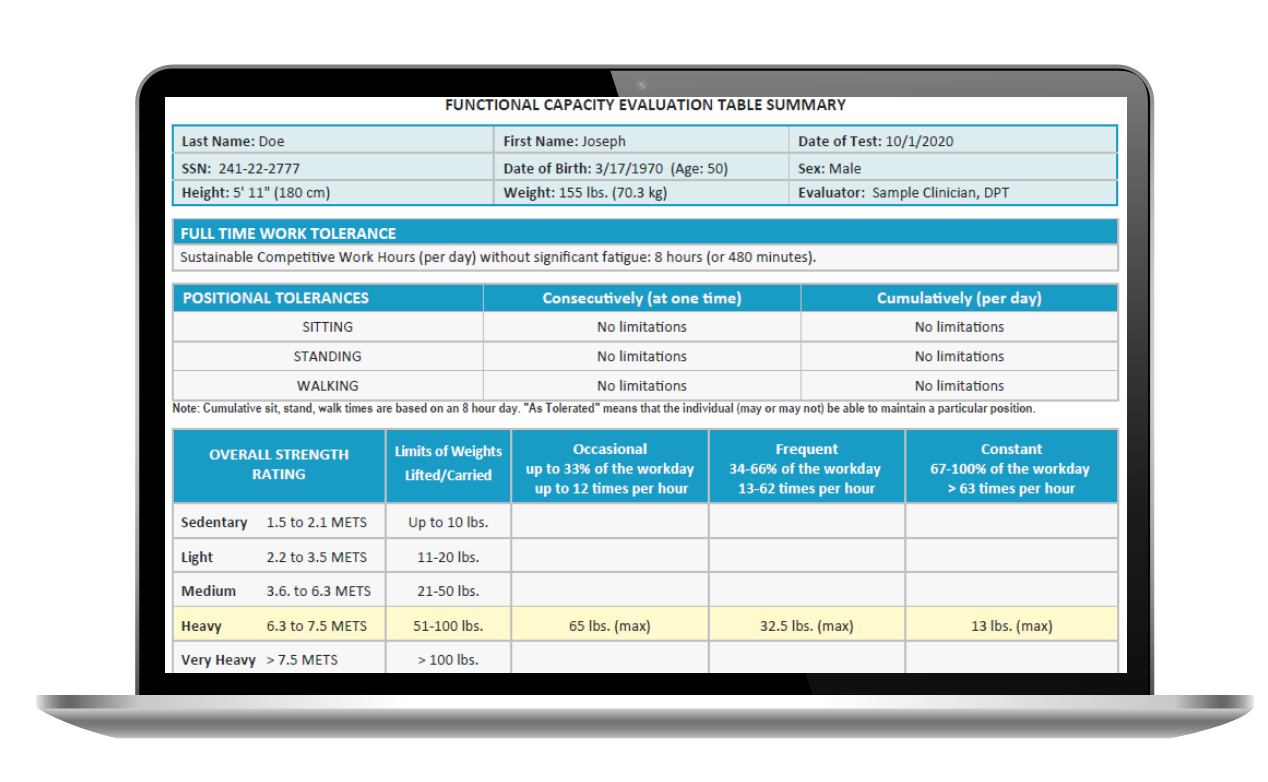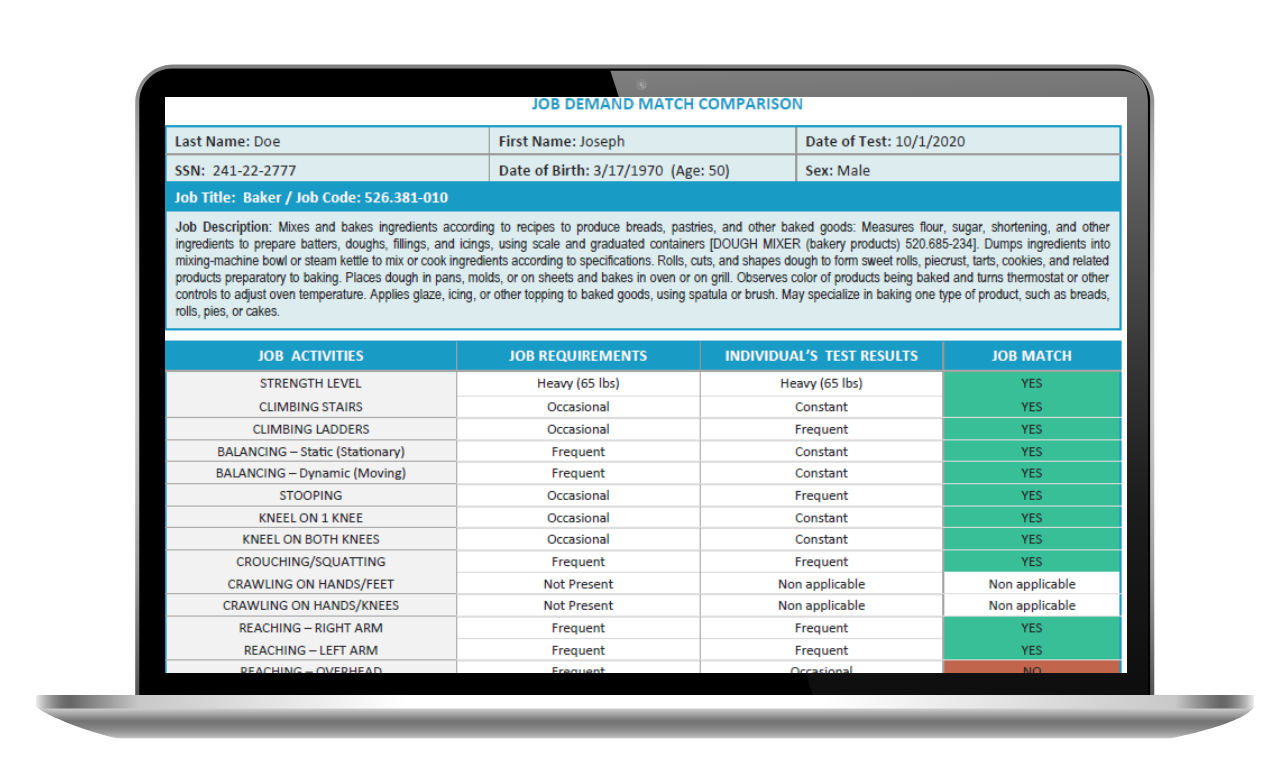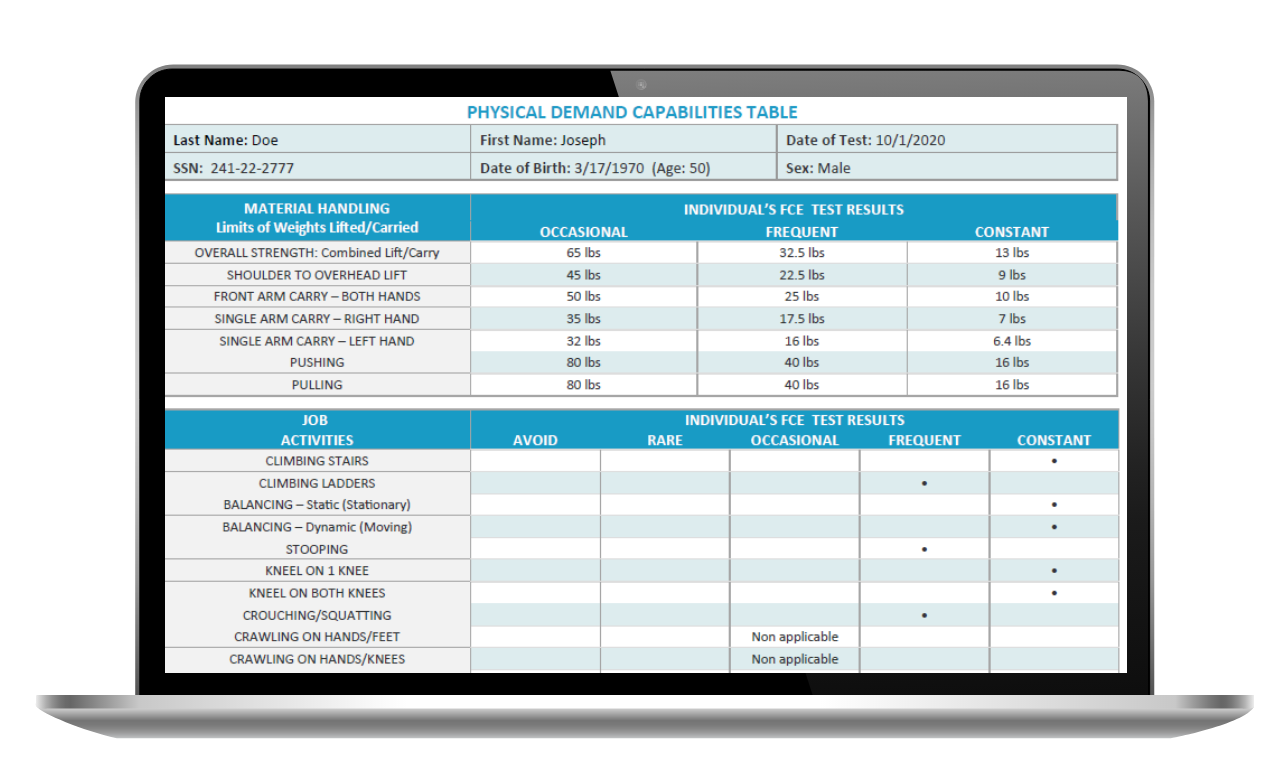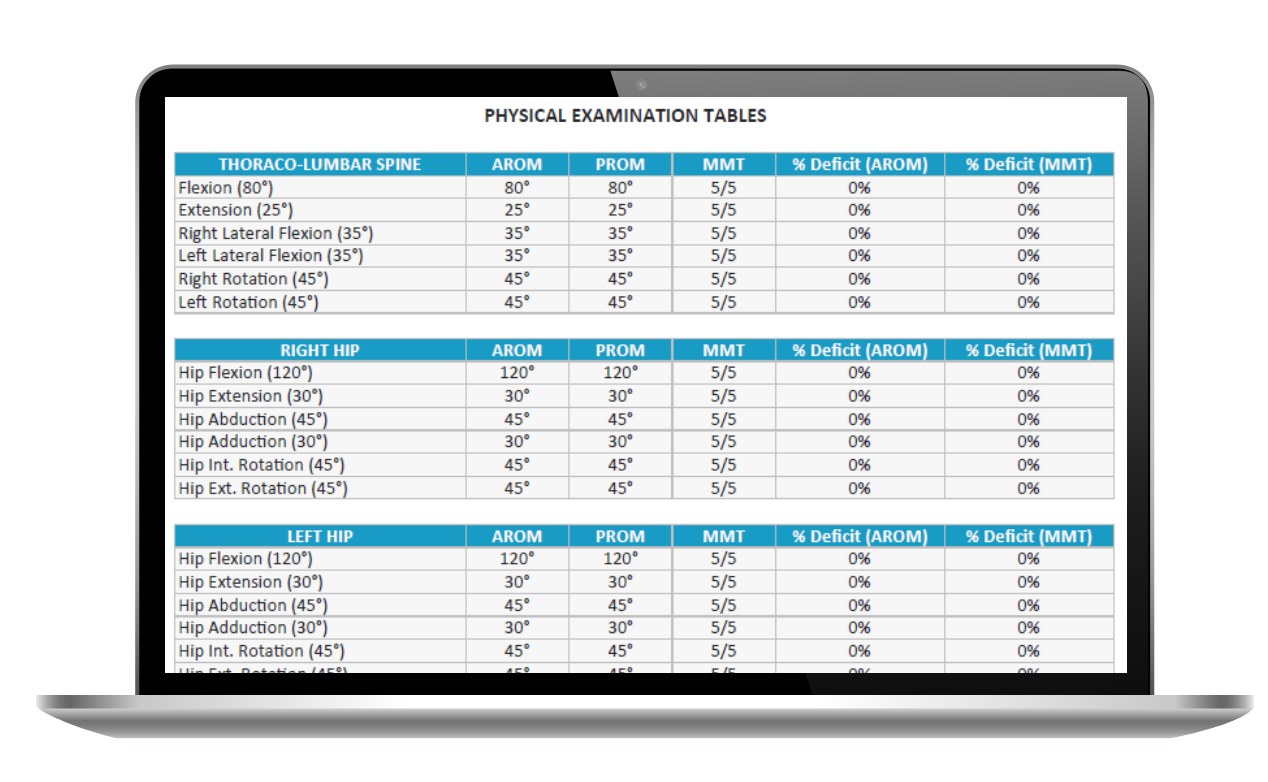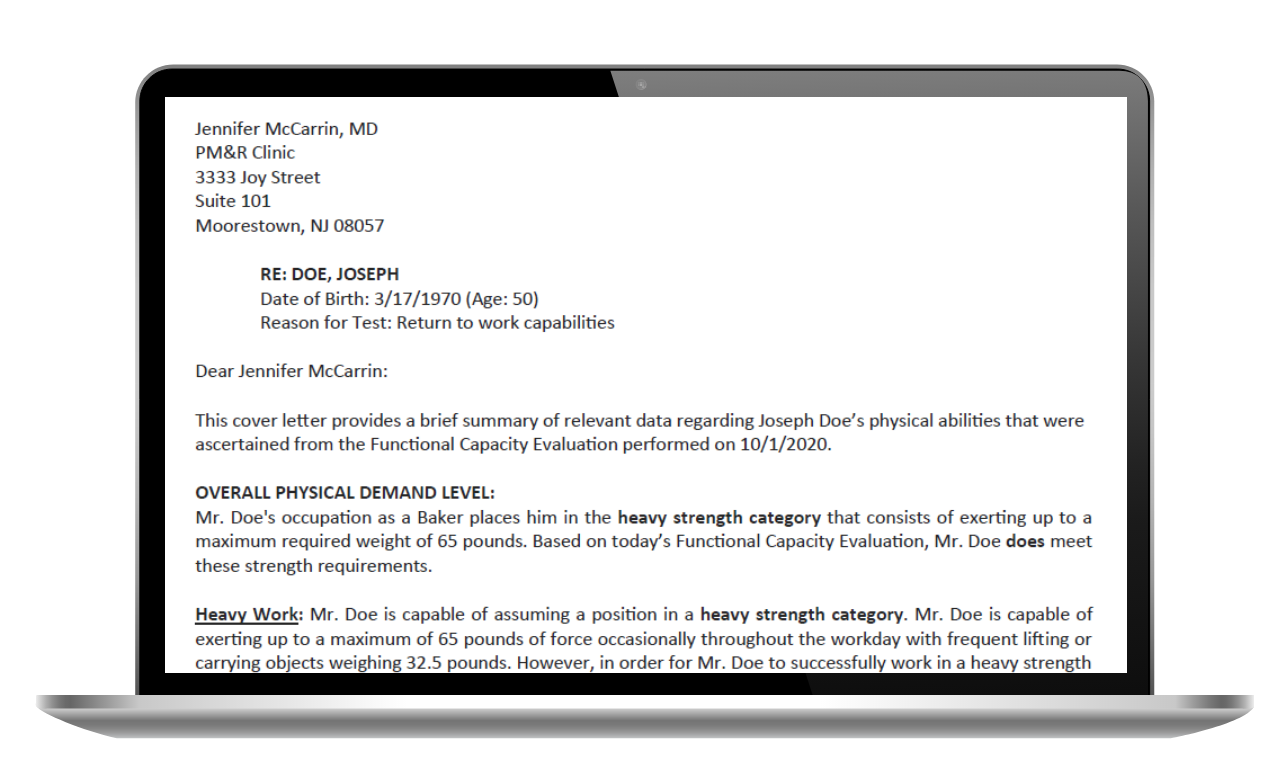Increase Revenue and Grow Your Practice With Our Cloud-Based FCE Software
Two Types of Functional Capacity Evaluations…
Ideal for Both Return to Work and Disability FCEs
Dictionary of Occupational Titles-Residual Functional Capacity (DOT-RFC) Battery
The DOT-RFC Battery is a Functional Capacity Evaluation (FCE) better suited for disability determinations. It tests and evaluates over 30 different job-related tasks (such as climbing, balancing, stooping, crouching, crawling, walking, kneeling, etc.) that an individual may be required to perform for any given occupation. The Battery measures an individual’s functional capacity based on peer reviewed norms. In other words, the norms for each job-related task tested along with the strength classification of a given occupation must be obtained in order for a person to return to that particular occupation in a safe and dependable manner. There are three key terms that need to be understood in order to correctly interpret and implement the results of the DOT-RFC Battery: Job Factors (JF), Residual Functional Capacity (RFC) and Demand Minimum Functional Capacity (DMFC). A job factor is one of about 30 different established specific job related tasks (such as lifting, walking, kneeling and grasping) that may be required to be performed in any given occupation. The residual functional capacity is the person’s actual performance level/potential attained for each job factor task tested; and the demand minimum functional capacity is the minimal acceptable level of performance for each job factor that a person must achieve before being able to safely return to work. Because the DOT-RFC Battery measures Residual Functional Capacity, it is a great choice for disability determination. Why? Because the clinician is able to select less strenuous testing protocols that are better suited to the individual’s limited capabilities &/or tolerances.
Dictionary of Occupational Titles-Return to Work (DOT-RTW) Battery
The DOT-RTW Battery is a Functional Capacity Evaluation (FCE) better suited for return to work determinations. In fact, it is an expanded variant of the Dictionary of Occupational Titles-Residual Functional Capacity (DOT-RFC) Battery. It tests over 30 different job-related tasks (such as climbing, balancing, stooping, crouching, crawling, walking, kneeling, etc.) that an individual may be required to perform for any given occupation. The Battery also measures an individual’s functional capacity based on peer reviewed norms. However, the main difference between the DOT-RTW Battery and the DOT-RFC Battery is the increased number of standardized tests that are required. The number of standardized tests can vary significantly depending on the DOT physical demands of the occupation. The DOT-RTW Battery incorporates numerous “standardized functional testing” and also includes additional specific “work simulation” testing for a more comprehensive and accurate return to work determination. The DOT-RTW Battery also includes additional tests and measurements such as outcome measures, consistency of effort (reliability & validity testing), standardized gross motor and fine motor dexterity assessments, standardized functional activity measurements, full-time work tolerance, work simulation, standardized balance and sensory testing and cardio-respiratory testing that are critical in determining a client’s actual functional abilities and work capacity. We did not alter the DOT-RFC Battery methodology but added additional components necessary to complete a comprehensive return to work FCE that will hold up in any court of law.
What Makes webFCE Unique?
Exceptional Performance
Confidently deliver FCE reports to physicians, employers, and legal professionals.
No Expensive Equipment
Easily conduct an FCE using standard physical therapy equipment and tests.
Peer-Reviewed
Data
Efficiently assess up-to-date, peer-reviewed, valid FCE outcomes. Perfect for legal cases.
Simplified
Pricing
Pricing designed to be affordable for everyone performing FCEs.
webFCE Software is Designed Around Peer-Reviewed Research
webFCE is based on the Dictionary of Occupational Titles-Residual Functional Capacity (DOT-RFC) Battery and has been shown to demonstrate face and content validity, construct validity, and reliability.1,2 The DOT-RFC Battery was created by Dr. Fishbain, et al. to identify the medical impairment of a person, express it in terms of functional limitations, and ultimately calculate the person’s actual work capacity.1 The Dictionary of Occupational Titles (DOT) is used in the evaluation process and defines numerous occupations and categorizes them into one of five progressively increasing strength classifications: sedentary, light, medium, heavy and very heavy.3
As a peer-reviewed FCE software, webFCE includes consistency of effort (patient validity testing), full-time work tolerance, outcome measurements, and cardio-respiratory testing. These additional assessments are critical to creating a comprehensive report and in determining a client’s true functional abilities and work capacity.
Every aspect of our software is supported with peer-reviewed literature for:
- Reliability and validity
- Work physiology: Eight-hour work tolerance
- Consistency of effort
- Standardized testing
The DOT-RFC Battery is legally defensible. It has been found to demonstrate:
- Excellent face and construct validity2,4
- Good test/re-test reliability1,5
- Good intra-rater reliability1,5
- Strong content validity2,4
- Predictive validity2
SIMILARITIES BETWEEN THE FUNCTIONAL CAPACITY EVALUATIONS:
- Both FCE’s can be done over one day (1 Day FCE) or two days (2 Day FCE).
- Both FCE’s (DOT-RFC & DOT-RTW Batteries) are used in conjunction and compliance with the most current versions of the APTA Standards of Practice for Physical Therapy6, the APTA Guide to Physical Therapist Practice, the AOTA Occupational Therapy Practice Framework: Domain & Process7, the International Classification of Functioning, Disability and Health8, AMA Guide to the Evaluation of Functional Ability: how to request, interpret, and apply functional capacity evaluations9, and Current Concepts in Functional Capacity Evaluation: A Best Practices Guideline Adopted April 30, 2018, APTA.10
| SIDE BY SIDE COMPARISON | DOT-RFC BATTERY | DOT-RTW BATTERY | ||
|---|---|---|---|---|
| TEST PROCEDURES | MANDATORY | OPTIONAL | MANDATORY | Depends on Occupation |
| Pre-Screen – Vital Signs, PAR-Q, Medical History | ||||
| Isoinertial Material Handling | ||||
|
||||
|
||||
|
||||
|
||||
|
||||
|
||||
|
||||
|
||||
| System Review/Physical Examination | ||||
|
||||
|
||||
|
||||
|
||||
|
||||
|
||||
| Sit, Stand & Walk Tolerance Testing | ||||
| Pain/Psychosocial Screening and other outcome scales | ||||
| Job Demand Analysis/DOT & O*NET job comparison | ||||
| Work Simulation Testing | ||||
| Full Time Work Tolerance Testing | ||||
| Balance Testing | ||||
|
||||
|
||||
|
||||
|
||||
| Gross & Fine Motor Testing | ||||
|
||||
|
||||
|
||||
|
||||
|
||||
|
||||
|
Purdue or Moberg | |||
|
||||
|
Minnesota or Box/Block | |||
|
||||
| Sensory Testing | ||||
|
||||
|
Two Point or Monofilament | |||
|
||||
| Functional Activity Testing | ||||
|
||||
|
||||
|
||||
|
||||
|
||||
|
||||
|
||||
|
||||
|
||||
|
||||
| Consistency of Effort Testing | ||||
| Cardio-Respiratory Fitness Testing | ||||
|
||||
Source
- Fishbain DA, et al. Measuring residual functional capacity in chronic low back pain patients based on the Dictionary of Occupational Titles, SPINE 1994;19(8)872-880.
- Fishbain DA, et al. Validity of the Dictionary of Occupational Titles-Residual Functional Capacity Battery. Clin J Pain 1999;15(2):102-110.
- U.S. Department of Labor, Employment and Training Administration. Dictionary of Occupational Titles, 4th edition: Supplement. Washington, DC: U.S. Government Printing Office, 1986.
- Innes E, Straker L. Validity of work related assessments. WORK 1999;13(2):125-152.
- Innes E, Straker L. Reliability of work related assessments. WORK 1999;13(2):107-124
- Guide to Physical Therapist Practice 3.0. 2014; http://guidetoptpractice.apta.org/.
- Association AOT. Occupational therapy practice framework: Domain and process (3rd ed.). American Journal of Occupational Therapy. 2014;68(Suppl. 1):S1-S48.
- International Classification of Functioning, Disability and Health (ICF). http://www.who.int/classifications/icf/en/. Accessed 11/17/17.
- Genovese E, Galper J. Guide to the Evaluation of Functional Ability: how to request, interpret, and apply functional capacity evaluations. American Medical Association. 2009.
- Current Concepts in Functional Capacity Evaluation: A Best Practices Guideline Adopted April 30, 2018, Academy of Orthopaedic Physical Therapy, April 30, 2018:1-43.
- Konz S. NIOSH lifting guidelines. Am Ind Hyg Assoc J. 1982;43(12):931-933.
- Dictionary of Occupational Titles. Vol II. Fourth ed: US Department of Labor; 1991.
- The Revised Handbook for Analyzing Jobs. Washington, DC: US Department of Labor; 1991.
